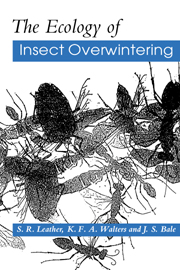4 - Insect cold-hardiness
Published online by Cambridge University Press: 16 September 2009
Summary
Introduction
Cold-hardiness is the most well documented aspect of insect over-wintering, with a number of comprehensive reviews (Salt 1961; Danks 1978; Zachariassen 1985; Cannon and Block 1988; Bale 1989) and many shorter review articles on limited parts of the subject including supercooling (Sømme 1982), ice nucleating agents (Zachariassen 1980, 1982; Duman 1982; Duman and Horwath 1983), protein antifreezes (Duman 1982; Duman et al. 1982; Duman and Horwath 1983), polyhydroxy alcohols (polyols) (Ring 1980; Zachariassen 1980), biochemistry and low temperature metabolism (Baust 1981; Storey 1984) and environmental triggers for cold-hardening (Baust 1982).
When Salt (1961) reviewed the ‘principles of insect cold-hardiness’, three main components were recognised: (i) cold acclimation; (ii) freeze tolerance; and (iii) freeze avoidance by supercooling. Over the last 25 years the subject has evolved to provide a clearer understanding of the structure and function of cryoprotective polyols and ice nucleating agents and thermal hysteresis (antifreeze) proteins have been discovered. This in turn has led to an expanding nomenclature in insect cold-hardiness where certain terms have often been used synonymously, e.g. supercooling and cold-hardiness, without clarification or definition, while other synonymous terminologies (e.g. frost susceptible, freezing susceptible, freezing sensitive and freezing intolerant) have been used preferentially by different authors leading to confusion and inconsistencies in published reports. Increasingly there has been a recognition that a standard terminology is required and at the outset this chapter provides a list of definitions and concepts from the modern literature based mainly on terms described by Zachariassen (1985).
- Type
- Chapter
- Information
- The Ecology of Insect Overwintering , pp. 75 - 147Publisher: Cambridge University PressPrint publication year: 1993
- 2
- Cited by



